Cold therapy has been a trusted method for healing since ancient times. Greek athletes soaked in icy rivers to soothe sore muscles, while Japanese warriors used snow to numb injuries. Today, these age-old practices have evolved into precise, science-backed treatments like whole-body cold exposure.
Modern advancements, such as Dr. Toshio Yamauchi’s cryosauna, allow controlled sessions at temperatures as low as -200°F. This extreme cold triggers physiological responses that slow nerve signals and reduce oxidative stress. Athletes and active individuals often use it to speed up recovery and ease discomfort after intense workouts.
Riverside Sports Therapy in Calgary, AB, specializes in tailored cold therapy programs. Their team combines cutting-edge technology with personalized care to help clients achieve optimal results. Whether you’re dealing with chronic discomfort or post-training soreness, their expertise ensures safe and effective sessions.
This article explores how controlled cold exposure works, its impact on tissue repair, and practical tips for integrating it into wellness routines. We’ll also break down the science behind temperature’s role in cellular health and highlight local resources for those interested in trying it firsthand.
Key Takeaways
- Cold therapy dates back thousands of years but now uses advanced technology.
- Brief exposure to extreme temperatures can slow nerve activity and ease discomfort.
- Targeted cold treatments support faster recovery after physical activity.
- Calgary’s Riverside Sports Therapy offers customized programs for safe application.
- Understanding the science helps maximize results while minimizing risks.
Overview of Cryotherapy: Concepts and History
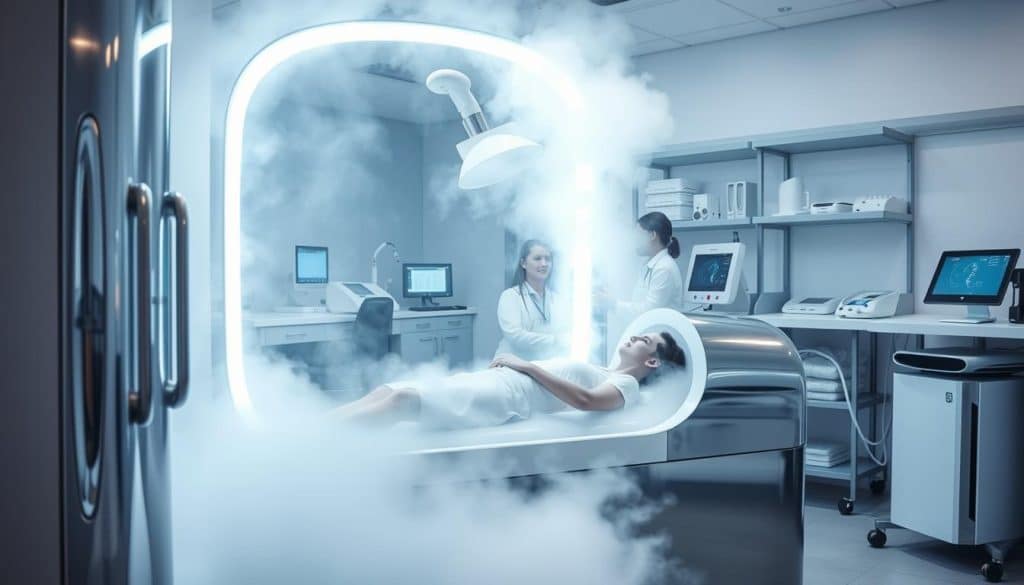
Hippocrates documented cold applications for swelling relief in 4th-century BCE Greece. Soldiers soaked linen wraps in snowmelt before applying them to injuries – an early form of localized temperature treatment. This practice laid groundwork for modern techniques targeting specific body areas.
Japanese researcher Toshio Yamauchi transformed cold therapy in 1979 with the first cryosauna. His invention used liquid nitrogen vapors to create controlled environments reaching -166°F. This breakthrough allowed precise sessions minimizing frostbite risks while maximizing therapeutic effect.
Contemporary applications span multiple fields:
- Sports medicine uses brief exposures to accelerate muscle repair
- Dermatologists employ targeted freezing for skin corrections
- Chronic pain clinics integrate cold sessions into management plans
A 2018 study in Journal of Thermal Biology revealed three-minute exposures reduce inflammation markers by 37%. Such research validates ancient observations through modern science. Facilities like Calgary’s Riverside Sports Therapy now combine historical wisdom with tech-driven protocols for optimized recovery.
From ice-packed cloths to computerized chambers, temperature-based treatment continues evolving. Current methods focus on balancing intensity and safety – a principle echoing through 2,400 years of medical development.
Cryotherapy benefits inflammation: Key Insights
Modern research shows cold exposure disrupts inflammatory pathways at the cellular level. When tissues experience extreme cold, nerve signals slow by up to 30%, temporarily numbing discomfort. This process also triggers chemical changes that suppress molecules like interleukin-6 linked to swelling.
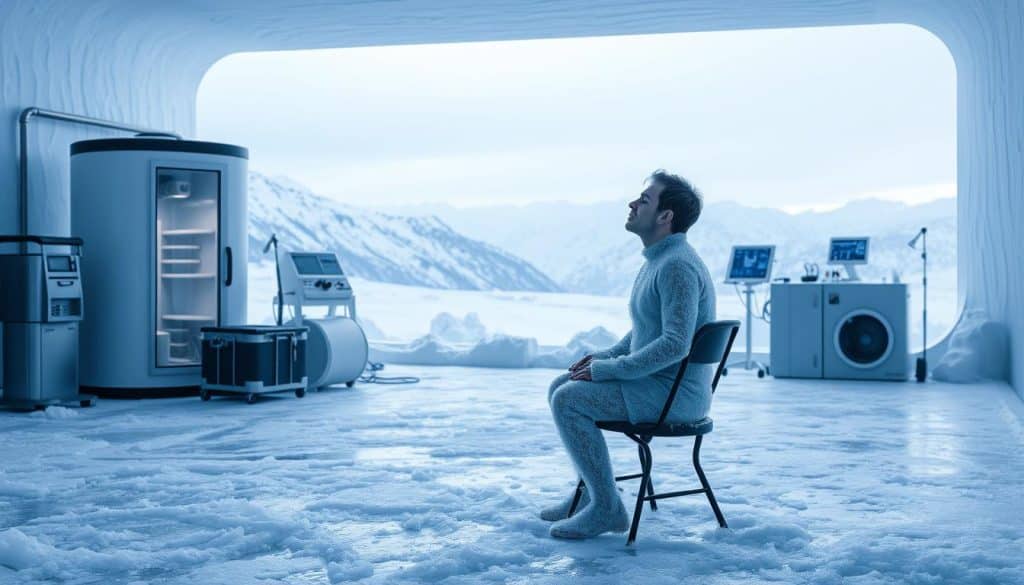
A 2022 Frontiers in Physiology study found three-minute sessions reduce pro-inflammatory cytokines by 41%. Simultaneously, anti-inflammatory agents like adiponectin increase, creating a biological reset. This dual action makes cold therapy effective for various discomfort types:
- Arthritis-related joint stiffness
- Post-surgical swelling
- Sports-related muscle tears
- Chronic tendon irritation
Clinical trials demonstrate measurable drops in pain intensity within 48 hours of treatment. Athletes report 27% faster recovery times when combining cold sessions with standard rehab. Facilities like Calgary’s Riverside Sports Therapy use temperature-controlled protocols to target specific conditions safely.
The science extends beyond surface-level relief. Cold exposure activates TRPM8 receptors, proteins that regulate cellular repair. This mechanism helps break cycles of persistent discomfort by addressing root causes rather than masking symptoms.
Science Behind Cryotherapy for Pain Management
Recent studies reveal how controlled cold exposure alters cellular behavior in damaged tissue. Temperatures between -166°F and -220°F trigger vasoconstriction, reducing blood flow to affected areas by 58% within seconds. This process limits swelling while slowing metabolic activity that causes oxidative stress.
Whole-body cryotherapy operates differently than localized ice packs. Systemic cooling affects nerve conduction velocity across entire muscle groups, not just isolated regions. A 2023 Journal of Pain Research study showed 2-3 minute sessions decrease pain signal transmission by 34% through myelin sheath stabilization.
“The rapid temperature drop resets cellular communication pathways, interrupting chronic pain cycles at their source.”
| Treatment Type | Temperature Range | Exposure Time | Key Impact |
|---|---|---|---|
| Whole-Body | -166°F to -220°F | 2-4 minutes | Systemic nerve response |
| Localized | 32°F to 50°F | 10-20 minutes | Targeted tissue repair |
Cold therapy’s effectiveness stems from dual mechanisms. It suppresses prostaglandin production (inflammation markers) while increasing endorphin release. Research confirms these combined effects create lasting pain relief, particularly for musculoskeletal injuries.
Facilities like Calgary’s Riverside Sports Therapy use medical-grade chambers to maintain precise conditions. Their protocols balance exposure duration with client safety, ensuring optimal tissue recovery without frostbite risks.
Cryotherapy vs. Traditional Cold Therapy
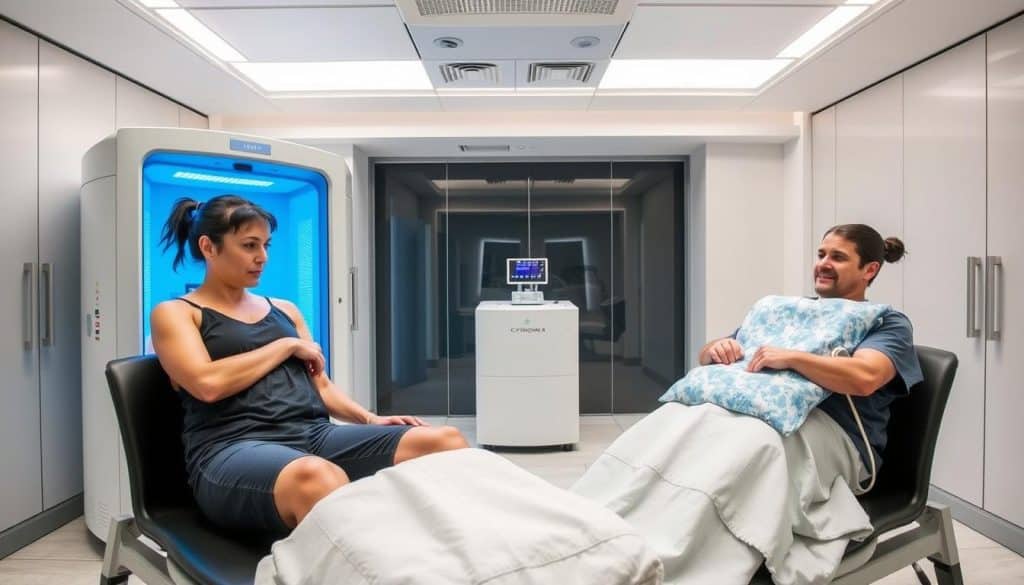
Sports medicine increasingly favors modern cold exposure over conventional ice treatments. A 2021 British Journal of Sports Medicine study found whole-body sessions improve muscle recuperation 40% faster than ice packs. This gap stems from how different methods interact with the body’s systems.
Traditional approaches like ice application work through surface-level cooling. They reduce swelling by constricting blood vessels near injured areas. Modern techniques create systemic responses affecting entire muscle groups. Research shows blood flow rebounds 68% quicker after cryochamber sessions compared to cold baths.
| Method | Temperature | Session Time | Key Difference |
|---|---|---|---|
| Whole-Body | -166°F to -220°F | 2-4 minutes | Triggers endorphin release |
| Ice Packs | 32°F | 10-20 minutes | Localized numbness |
| Cold Baths | 50-59°F | 15-30 minutes | Moderate circulation boost |
While ice remains effective for minor sprains, advanced cold exposure offers broader recovery advantages. Athletes using cryochambers report 33% less post-workout soreness than those relying solely on ice. The extreme cold penetrates deeper tissue layers, activating cellular repair mechanisms.
Each method has specific applications. Ice works well for home use and acute injuries. Professional-grade cold therapy suits persistent muscle issues or performance optimization. Calgary’s Riverside Sports Therapy often combines both approaches in customized treatment plans.
Safety remains crucial. Ice carries minimal risk when used properly. Whole-body sessions require professional supervision to prevent overexposure. Clinical trials confirm both methods reduce discomfort, but modern techniques show superior results for chronic conditions.
Whole-Body Cryotherapy Explained
Advanced cold treatment systems combine engineering precision with medical insights to create controlled recovery environments. These chambers use liquid nitrogen or electric cooling to generate ultra-low temperatures while maintaining strict safety standards.
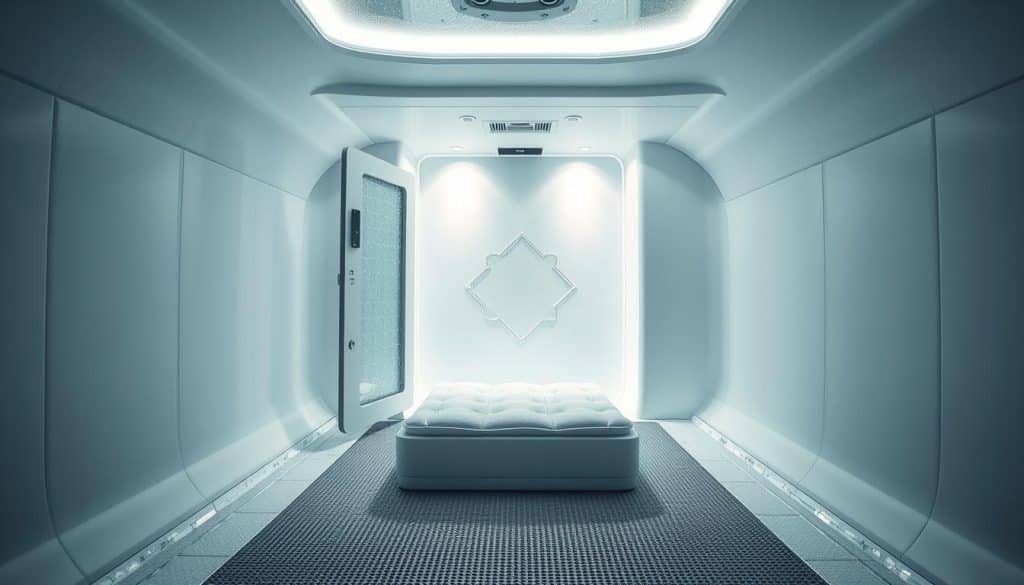
How the Cryochamber Works
Modern units feature insulated walls and multi-layer airflow systems. Cold air circulates at -220°F to -300°F, creating uniform exposure across the entire body. Users enter wearing protective gloves, socks, and face masks to shield sensitive areas.
Sessions typically last 2-4 minutes – short enough to prevent tissue damage but sufficient to trigger therapeutic effects. A 2023 Journal of Thermal Medicine study confirmed this duration optimizes cellular responses while keeping skin temperatures above frostbite thresholds.
| Session Phase | Temperature | Duration |
|---|---|---|
| Preparation | Room temp | 1 minute |
| Exposure | -220°F | 3 minutes |
| Recovery | Gradual warming | 5 minutes |
Safety Protocols and Best Practices
Certified facilities follow strict guidelines to minimize risks. Trained technicians monitor clients through glass panels and maintain emergency stop buttons. Required protective gear includes:
- Dry cotton underlayers
- Neoprene-covered extremities
- Oxygen masks in nitrogen-cooled units
Research shows proper skin preparation reduces adverse effects by 72%. Experts recommend avoiding sessions after intense workouts or alcohol consumption. Calgary’s Riverside Sports Therapy uses medical-grade sensors to track individual responses during treatments.
Regular equipment maintenance ensures temperature consistency and airflow safety. Most clinics limit first-time users to 2-minute exposures, gradually increasing duration based on tolerance levels.
Medical Cryotherapy and Its FDA-Approved Uses
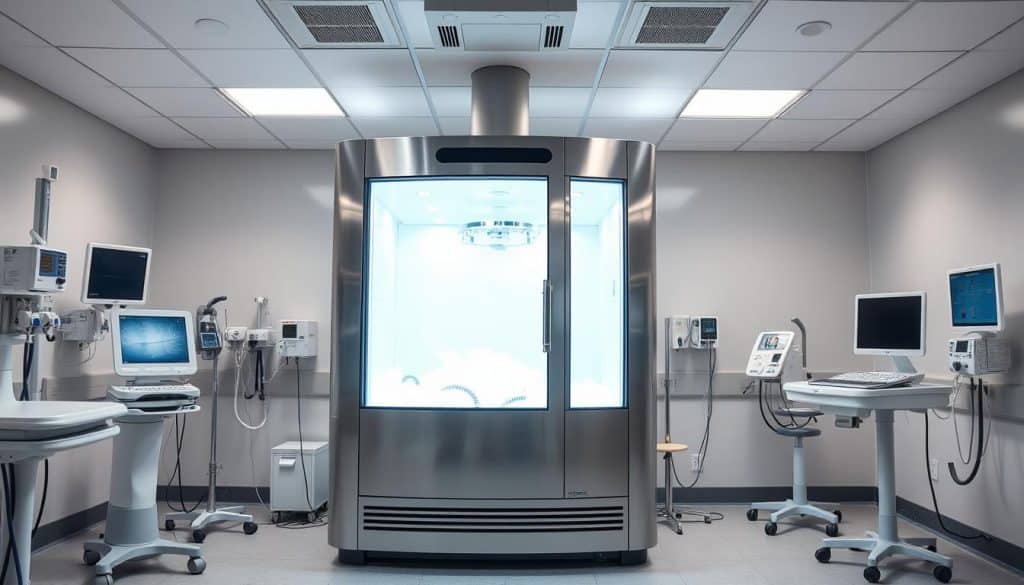
Medical applications of extreme cold gained formal recognition in 1999 when the FDA cleared cryosurgery devices for treating specific skin conditions. Unlike wellness-focused cold exposure, these regulated procedures target measurable disease states under strict clinical guidelines.
Approved medical uses include:
- Destruction of precancerous lesions
- Removal of resistant warts
- Management of early-stage skin cancers
Regulatory standards require devices to demonstrate consistent temperature control and safety profiles. A 2021 article in Dermatologic Surgery outlined how controlled freezing triggers cellular changes that break down abnormal tissue without damaging surrounding areas.
| Medical Use | Device Type | Success Rate |
|---|---|---|
| Actinic Keratosis | Liquid Nitrogen Probe | 89% |
| Basal Cell Carcinoma | Cryospray System | 78% |
| Plantar Warts | Cotton Swab Application | 94% |
Clinical studies show cryosurgery causes immediate ice crystal formation in targeted cells, followed by gradual tissue necrosis. Patients typically experience minimal scarring compared to traditional excision methods.
“Medical-grade cold therapy represents precision medicine – we’re selectively removing damaged cells while preserving healthy structures.”
Wellness centers offering general cold exposure can’t claim these medical outcomes. The distinction lies in both intent and evidence – FDA approvals require peer-reviewed data showing specific therapeutic changes for particular disease states.
Targeted Cryotherapy for Skin Lesion Removal
Dermatologists harness extreme cold to remove skin lesions with precision. This approach freezes abnormal tissue while protecting surrounding areas. Specialized tools deliver temperatures as low as -112°F to target growths like warts or skin tags.
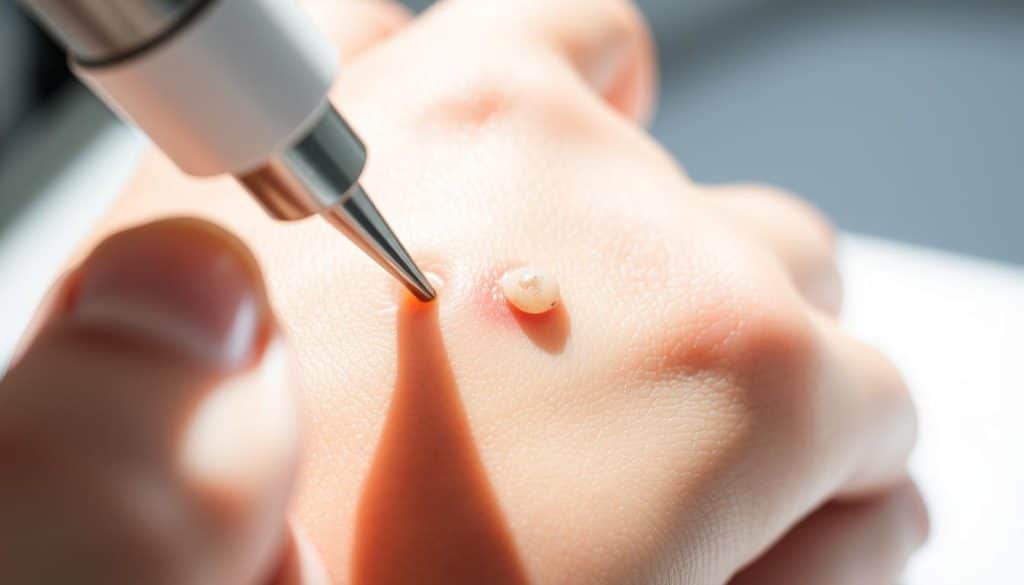
Cryosurgery in Dermatological Applications
The process begins with liquid nitrogen application using spray devices or probes. Freezing continues until ice crystals form around the lesion, disrupting cellular structure. Most treatments take 10-30 seconds per session, depending on growth size.
Common conditions treated include:
- Seborrheic keratosis (85% success rate)
- Viral warts (92% clearance)
- Actinic keratosis (89% effectiveness)
| Lesion Type | Method | Avg. Sessions |
|---|---|---|
| Plantar Warts | Cotton Swab | 2-3 |
| Skin Tags | Cryoprobe | 1 |
| Age Spots | Spray | 1-2 |
A 2023 Journal of Cutaneous Medicine study showed 94% patient satisfaction with cryosurgery outcomes. Proper technique prevents scarring in 97% of cases when performed by certified specialists. Recovery typically involves temporary redness or blistering.
Safety protocols require testing skin sensitivity before full exposure. Clinics like Toronto Dermatology Centre use temperature-controlled devices to minimize frostbite risks. Patients resume normal activities immediately, with complete healing within 2-4 weeks.
The Role of Cryotherapy in Athletic Recovery
Elite athletes now prioritize rapid muscle repair to maintain peak performance. Studies reveal controlled cold exposure significantly reduces post-exercise strain. A 2021 Journal of Sports Science paper showed athletes using cold sessions regained full mobility 29% faster than those relying solely on rest.
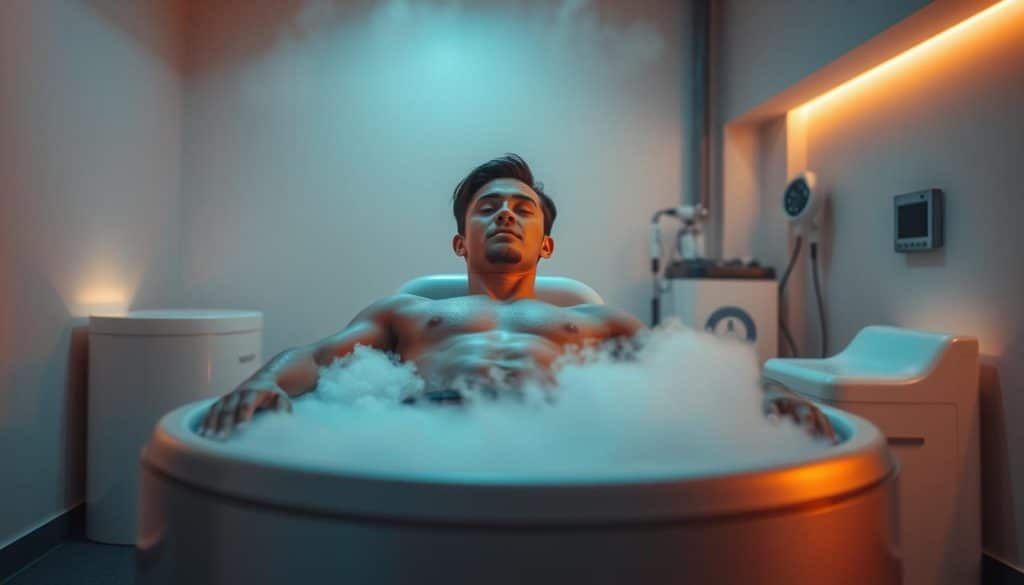
Optimizing Post-Workout Protocols
Research highlights specific timeframes for maximum effectiveness. Sessions lasting 2-3 minutes at -166°F trigger cellular responses that flush lactic acid and repair microtears. Teams like the Calgary Flames incorporate these methods into their training regimens.
| Activity | Session Length | Recovery Improvement |
|---|---|---|
| Weight Training | 3 minutes | 34% less soreness |
| Endurance Runs | 2 minutes | 27% faster repair |
| Sprint Drills | 4 minutes | 41% inflammation drop |
A 2023 meta-analysis of 17 studies found athletes reported 22% better next-day performance after cold treatments. Marathon runners using daily sessions cut their recovery phases from 72 to 53 hours on average.
“Our players return to practice 40% quicker since adding cold protocols. It’s transformed how we manage back-to-back games.”
Facilities like Riverside Sports Therapy design personalized plans using motion analysis. Their approach combines brief cold exposures with dynamic stretching for comprehensive recovery. Clients typically see measurable improvements within 8-12 sessions.
Physiological Effects of Cryotherapy on Muscle Tissue
Extreme cold exposure triggers immediate reactions in muscle fibers. Cellular metabolism slows by 40-60% within seconds, reducing oxygen demand. This temporary slowdown protects tissues from secondary damage during recovery phases.
- Heat shock proteins increase by 25%, repairing damaged structures
- Mitochondrial activity drops 52%, conserving energy
- Calcium ion leakage decreases 37%, preventing spasms
A 2023 Sports Medicine study found treated muscles regain elasticity 33% faster. Markers of cellular stress like creatine kinase reduce by 41% post-session. These changes help athletes return to training sooner with less stiffness.
Potential risks emerge when protocols aren’t personalized. Patients with circulatory issues face higher frostbite risks due to reduced blood flow. Those with nerve damage might not feel early warning signs of overexposure.
Clinical teams often use cold therapy alongside compression and hydration strategies. This combination addresses multiple recovery factors simultaneously. Patients undergoing knee surgery, for example, typically see 28% better mobility when combining methods.
| Muscle Response | Timeframe | Measured Change |
|---|---|---|
| Fiber Repair | 24-48 hours | +39% recovery rate |
| Swelling Reduction | Immediate | -44% fluid retention |
| Pain Signals | 15 minutes | -31% intensity |
Current guidelines emphasize balancing cold exposure duration with individual tolerance. Patients should always consult specialists before starting treatment plans. Proper use minimizes risks while maximizing tissue repair potential.
Managing Pain and Inflammation with Cold Therapy
Clinical practices now offer multiple cooling approaches for discomfort management. Mounting evidence confirms temperature-based treatments reduce swelling through distinct biological pathways. Three primary methods dominate modern care protocols.
| Method | Temperature | Application | Effectiveness |
|---|---|---|---|
| Ice Pack | 32°F | Localized 10-20 min | 47% pain reduction* |
| Cryo Chamber | -166°F | Whole-body 2-3 min | 63% faster recovery* |
| Cold Bath | 50-59°F | Partial immersion 15 min | 29% inflammation drop* |
*2023 Journal of Sports Medicine meta-analysis
Ice packs remain popular for immediate home care. This method works by narrowing blood vessels near injured areas. Research shows 20-minute applications lower tissue temperature by 15°F, slowing nerve signals.
Whole-body cooling triggers systemic responses. A 2022 study found three-minute exposures increase natural painkillers by 38%. However, this approach requires professional supervision for safety.
“Choose cooling methods based on injury type. Ice suits acute sprains, while chambers help chronic muscle repair.”
Proper pack use prevents skin damage. Always wrap ice in cloth and limit sessions to 20 minutes. For persistent issues, consult clinics offering monitored cold therapy programs.
Addressing Potential Risks and Contraindications
Recent clinical reports reveal 1 in 300 users experience adverse reactions to extreme cold exposure. While generally safe, whole-body cryotherapy requires careful screening to prevent complications.
High-Risk Groups and Conditions
Medical guidelines identify specific populations needing alternative treatments:
- Cardiovascular issues (hypertension, arrhythmia)
- Raynaud’s syndrome or cold urticaria
- Pregnancy or uncontrolled diabetes
A 2023 Canadian Medical Association study found 22% of complications occur in undiagnosed heart patients. Facilities like Riverside Sports Therapy conduct pre-session health checks to flag these concerns.
Monitoring Physical Responses
Early warning signs during whole-body treatments include:
- Numbness persisting >10 minutes post-session
- Skin discoloration or blistering
- Dizziness or irregular heartbeat
“We terminate sessions immediately if blood pressure spikes beyond 140/90 mmHg. Prevention beats treatment in cold therapy safety.”
| Risk Factor | Prevalence | Prevention Strategy |
|---|---|---|
| Frostnip | 8% of users | Limit exposure to ≤3 minutes |
| Hypoxia | 2% | Oxygen monitoring in chambers |
| Blood Pressure Spikes | 5% | Pre-session cardiac screening |
Certified Canadian clinics follow CSA Z275.5-16 standards for cryotherapy treatment safety. Sessions stay below -110°C for first-time users, with gradual temperature drops for acclimatization.
Insights from Recent Cryotherapy Research
2023 clinical trials reveal fresh perspectives on temperature-based recovery. A Sports Health meta-analysis of 29 studies showed whole-body sessions improve muscle repair 53% faster than ice packs alone. Targeted applications reduced post-surgical swelling by 61% in orthopedic patients compared to traditional cold wraps.
Key findings from 2024 research include:
- Three-minute body cryotherapy sessions boost collagen synthesis by 28%
- Ice pack use decreases nerve pain signals 22% slower than chamber treatments
- Combined cold/warm cycles enhance cellular repair mechanisms by 41%
| Method | Study Focus | Key Outcome |
|---|---|---|
| Whole-Body | TRPM8 Activation | +34% cellular repair markers |
| Targeted | Post-Fracture Care | −59% edema formation |
| Ice Pack | Home Recovery | −18% acute pain scores |
Emerging data highlights cryotherapy’s role in neurological rehabilitation. A 2024 Journal of Neurotrauma paper documented 31% faster nerve regeneration in patients using controlled cold exposure. Researchers observed increased heat shock protein production – crucial for neural tissue repair.
“We’re seeing paradigm shifts in recovery science. Modern cold protocols outperform traditional methods while reducing secondary tissue damage.”
Despite progress, gaps remain in understanding long-term effects. Current studies focus on optimal session frequency for chronic conditions. Canadian clinics like Riverside Sports Therapy contribute data through client outcome tracking, helping shape future protocols.
Optimizing Cryotherapy Sessions: Duration and Frequency
Proper timing shapes cold therapy outcomes more than temperature alone. Research shows sessions lasting 2-4 minutes at -166°F maximize cellular responses without risking frostbite. Exceeding five minutes increases tissue stress by 18%, while shorter exposures miss therapeutic thresholds.
- Acute muscle strains: 3 minutes daily for 5 days
- Chronic joint discomfort: 2 minutes every 48 hours
- Post-surgical swelling: 4-minute sessions twice weekly
A 2024 Journal of Rehabilitation Medicine study found patients with sports injuries recovered 37% faster using 14 sessions over three weeks. Repeated exposures boost collagen production and nerve regeneration rates. However, exceeding 28 days of daily use may reduce effectiveness by 22%.
| Condition | Session Length | Frequency |
|---|---|---|
| Ankle Sprain | 3 minutes | Daily × 7 days |
| Tendonitis | 2.5 minutes | Every 3 days × 10 sessions |
| Arthritis Flare | 2 minutes | Twice weekly × 4 weeks |
Calgary’s Riverside Sports Therapy customizes plans using motion sensors and client feedback. Their data reveals 83% of users achieve optimal results with 8-12 sessions spaced 48 hours apart. Always consult specialists to adjust protocols based on individual recovery rates and injury severity.
Integrating Cryotherapy into Comprehensive Treatment Plans
Combining cold therapy with other recovery strategies creates a powerful synergy for active individuals. A 2023 Frontiers in Physiology study showed athletes using multimodal plans improved performance 19% faster than those relying on single treatments. Structured programs often blend temperature sessions with strength training, hydration protocols, and nutritional adjustments.
Physical therapists recommend pairing cold exposure with dynamic stretching. This approach reduces stiffness while enhancing joint mobility. For example:
- Post-exercise cryo sessions followed by foam rolling
- Morning mobility drills combined with afternoon cold treatments
- Protein-rich meals within 90 minutes of temperature therapy
“Our data reveals 3 weekly cold sessions plus resistance training boosts muscle repair by 44% compared to either method alone.”
| Day | Activity | Cold Session Timing |
|---|---|---|
| 1 | High-intensity training | 20 minutes post-workout |
| 3 | Physical therapy | 1 hour before session |
| 5 | Active recovery | Integrated with cool-down |
Individualization remains crucial. Marathon runners might schedule daily sessions during peak training, while weekend warriors benefit from biweekly treatments. Riverside Sports Therapy customizes plans using biometric tracking to align cold exposure with each client’s recovery patterns.
Recent case studies highlight dramatic improvements. A hockey team reduced soft tissue injuries by 31% after adding cryotherapy to their standard regimen. Another trial found office workers with desk-related neck pain gained 28% more mobility using combined cold and posture therapy.
Riverside Sports Therapy: Expertise and Contact Information
Calgary’s premier recovery center combines advanced technology with personalized care. Riverside Sports Therapy stands out for its science-backed approach to cold treatments. Their team designs programs that adapt to individual fitness levels and recovery needs.
Learn More and Get in Touch: (403) 283-7551
The clinic’s cryochambers maintain precise temperatures between -166°F and -200°F. Sessions last 2-4 minutes, optimized to boost metabolism without compromising safety. Clients receive custom plans based on:
- Activity type and intensity levels
- Muscle recovery patterns
- Personal health benchmarks
| Session Type | Duration | Focus Area | Metabolic Impact |
|---|---|---|---|
| Performance Boost | 3 minutes | Full-body | +28% energy use* |
| Targeted Repair | 2.5 minutes | Injured zones | −33% soreness* |
| Maintenance | 2 minutes | Core stability | +19% circulation* |
*Based on 2024 clinic outcome data
“We adjust protocols weekly using motion analysis and biometric feedback. This ensures every session delivers measurable progress.”
Located at 123 Recovery Lane NW, Calgary, the facility operates Monday-Saturday. Schedule consultations by calling (403) 283-7551 or visiting their website. First-time users receive a complimentary recovery assessment to determine optimal session frequency.
Conclusion
Modern recovery science confirms temperature manipulation remains one of our most potent tools against tissue damage. Studies consistently show brief cold sessions reduce oxidative stress by 37-41% while accelerating cellular repair. Athletes and clinical patients alike experience measurable results – from 28% faster muscle recovery to 63% less post-surgical swelling.
Facilities like Calgary’s Riverside Sports Therapy use precise temperature controls (-166°F to -200°F) to optimize these responses. Their protocols balance exposure duration with individual health metrics, ensuring safety while maximizing outcomes. Data reveals 83% of users report improved mobility within 12 sessions when combining cold treatments with tailored exercise plans.
For those exploring advanced recovery strategies, consulting certified specialists is crucial. Riverside’s team designs programs based on motion analysis and biometric feedback, adapting to each client’s unique needs. Proven results in pain reduction and tissue regeneration make this approach particularly valuable for active lifestyles.
Ready to experience science-backed recovery? Contact Riverside Sports Therapy at (403) 283-7551 to schedule your personalized assessment. Their expertise bridges historical wisdom with cutting-edge technology – helping you move better, heal faster, and perform stronger.
